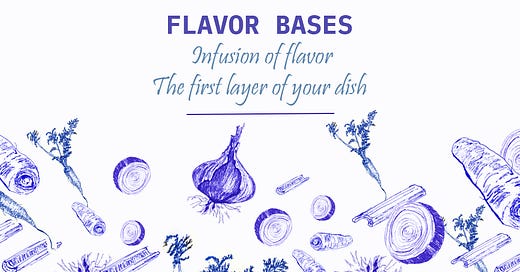The Humble Beginnings: Mastering Flavor Bases
Including a complete flavor base guide to get started
Almost every cuisine in the world has its own simple, vegetable base, that lends its flavors to traditional dishes as a cultural tradition. These combinations of vegetables, herbs, and fats are more than ingredients; they’re stories simmering in a pot, filled with history, memory, and tradition.
We all intuitively start many dishes with some union and garlic, a very simple form of a flavor base. I, too, followed this instinct without truly grasping its significance. That changed the day I was tasked with making risotto for guests on an Ayurvedic diet, which forbade both onion and garlic. Without these cornerstone ingredients, the dish was reduced to creamy rice and vegetables—technically edible but utterly uninspired. It lacked the depth, the zing, the soul of a true risotto. A terrible waste of risotto.
This experience opened my eyes to the importance of flavor bases. They’re universal, yet deeply tied to tradition, and understanding how they work can elevate your cooking to new heights.
For me the world of flavor bases most of all demystified the intense flavor of curries. For some reason, my curries were always a bit off. As a student, we would often serve 'curry' - rice with vegetables in coconut milk. However, it was always missing that rich, complex flavor I craved. I shamefully remember serving spinach and feta in coconut milk and having the audacity of calling it 'Palak Paneer'- cringe, what a joke.
Last week, I put my notes to practice and started of with a Indian flavor base of union, garlic, chili and ginger in ghee. The moment the ingredients hit the heat, the aroma filled my kitchen, unmistakably transporting me to the world of authentic Indian curries. For the first time, I made Palak Paneer that deserved the name. When the dish was served, all that was missing was an airy, soft naan with slowly melting butter and garlic on the sight - but I was proud.
Knowing some of the fundamental and traditional flavor bases, are like having building blocks in your kitchen. Once you understand their principles, you can apply them across cuisines and ingredients, creating authentic, deeply flavorful dishes.
Flavor bases
Flavor bases are named 'humble beginnings' and therefore all the more appropriate as the first theme. Flavor bases are all recipe starters, consisting of vegetables, herbs and a form of fat. From the buttery mirepoix of France to the olive oil-infused soffritto of Italy, from Spain’s sofrito to Germany’s Suppengrün, each base tells a story of its culinary roots.
What do you need to build a flavor base
Fat
The type of fat reflects the cuisine. For example, French mirepoix uses butter, Italian soffritto starts with olive oil, and Indian flavor bases are often built on ghee.
Aromatic Vegetables
Common ingredients include onion, carrot, celery, ginger, and peppers. Each cuisine has its signature blend that defines its unique identity.
Spices and Herbs
These are the soul of a flavor base. Indian bases may include cardamom and cumin, while Thai bases might feature lemongrass and kaffir lime leaves.
Flavor Enhancers
Tomato paste, chipotle, or even soy sauce can deepen and enrich a base, sometimes transforming it into a paste-like mixture for added intensity.
How do you make a flavor base
Even though flavor bases are an intuitive part of cooking, they are not so strict with recipe when it comes to bases:
Heat a pan and add your chosen fat.
Slowly cook the aromatic vegetables, herbs, and spices over low heat, allowing their flavors to develop fully.
Stir occasionally to prevent burning and ensure even cooking.
That’s it—a small, patient effort that lays the foundation for bold, complex flavors.
Overview of Common Flavor Bases
Below, you’ll find an overview of the most common flavor bases, including their typical ingredients and ratios. Using these specific combinations is a game-changer for bringing out authentic flavors in your dishes. Once you’ve mastered these traditional bases, feel free to experiment and make them your own!
What to Do with Flavor Bases
So, you’ve made a flavor base—now what? These versatile starters can transform a variety of dishes:
Roasting: Toss your favorite vegetables or proteins in the flavor base before roasting to infuse them with rich, layered taste.
Stocks and Broths: Use the base as the starting point for homemade stocks, adding depth and complexity to soups and stews.
Sauces: Deglaze the base with wine, broth, or water to create a flavorful sauce.
Curries and Braises: Simmer the base with additional ingredients like coconut milk, tomatoes, or spices to build bold curries and braised dishes.
Pasta Dishes: Incorporate a base like soffritto directly into your pasta for a simple yet intensely flavorful dish.
A Flavorful Pasta Hack
Here’s an example of how I used soffritto to create a quick and delicious pasta:
Start by making soffritto: gently sauté onion, carrot, and celery in olive oil until softened and fragrant.
Add dry pasta directly into the pan with the soffritto, then pour in boiling water and a cup of soy milk to cover.
Stir continuously as the pasta cooks in the liquid, which thickens into a creamy sauce infused with the soffritto’s flavors.
Finish with some fried vegetables for texture, and dinner is served—a simple, flavorful, one-pan dish!
An Quick, Unrelated Union Hack
Some days, peeling onions feels like a battle, with the skin clinging on for dear life. That was until a colleague shared a simple trick with me: soak your onions in lukewarm water for a few minutes.
The result? The skin practically slides off, saving you time and effort. No more wrestling with stubborn onion layers—just quick, hassle-free prep so you can focus on cooking!
Your flavor base guide to get started
Enjoy cooking!





